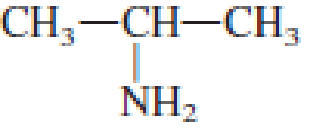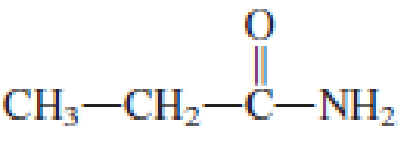
Study Guide with Selected Solutions for Stoker's General, Organic, and Biological Chemistry, 7th
7th Edition
ISBN: 9781305081086
Author: STOKER, H. Stephen
Publisher: Brooks Cole
expand_more
expand_more
format_list_bulleted
Concept explainers
Textbook Question
Chapter 17, Problem 17.7EP
Indicate whether or not each of the following compounds contains an




Expert Solution & Answer
Trending nowThis is a popular solution!

Students have asked these similar questions
Which of the following amines has the LOWEST boiling point?
ethylhexylamine
triethylammonium chloride
triethylamine
non-1-amine
Write the names for the amines using the naming styles taught in the McMurry text.
H2
H3C-N-C-CH3
name:
H2
H2
H3C-C-Ņ-c-CH3
H
name:
These compounds are
amines.
Which of the following compounds contain an amine functional group?
NH2
OH
NH2
II
II
IV
O II
O IV
0= >
Chapter 17 Solutions
Study Guide with Selected Solutions for Stoker's General, Organic, and Biological Chemistry, 7th
Ch. 17.1 - Prob. 1QQCh. 17.1 - Prob. 2QQCh. 17.2 - Prob. 1QQCh. 17.2 - Prob. 2QQCh. 17.2 - Prob. 3QQCh. 17.2 - Prob. 4QQCh. 17.3 - Prob. 1QQCh. 17.3 - Prob. 2QQCh. 17.3 - Prob. 3QQCh. 17.3 - Prob. 4QQ
Ch. 17.4 - Prob. 1QQCh. 17.4 - Prob. 2QQCh. 17.5 - Prob. 1QQCh. 17.5 - Prob. 2QQCh. 17.5 - Prob. 3QQCh. 17.6 - Prob. 1QQCh. 17.6 - Prob. 2QQCh. 17.6 - Prob. 3QQCh. 17.7 - Prob. 1QQCh. 17.7 - Prob. 2QQCh. 17.7 - Prob. 3QQCh. 17.8 - Prob. 1QQCh. 17.8 - Prob. 2QQCh. 17.8 - Prob. 3QQCh. 17.8 - Prob. 4QQCh. 17.9 - Prob. 1QQCh. 17.9 - Prob. 2QQCh. 17.10 - Prob. 1QQCh. 17.10 - Prob. 2QQCh. 17.10 - Prob. 3QQCh. 17.10 - Prob. 4QQCh. 17.11 - Prob. 1QQCh. 17.11 - Prob. 2QQCh. 17.11 - Prob. 3QQCh. 17.12 - Prob. 1QQCh. 17.12 - Prob. 2QQCh. 17.12 - Prob. 3QQCh. 17.12 - Prob. 4QQCh. 17.13 - Prob. 1QQCh. 17.13 - Prob. 2QQCh. 17.13 - Prob. 3QQCh. 17.13 - Prob. 4QQCh. 17.14 - Prob. 1QQCh. 17.14 - Prob. 2QQCh. 17.14 - Prob. 3QQCh. 17.15 - Prob. 1QQCh. 17.15 - Prob. 2QQCh. 17.16 - Prob. 1QQCh. 17.16 - Prob. 2QQCh. 17.16 - Prob. 3QQCh. 17.17 - Prob. 1QQCh. 17.17 - Prob. 2QQCh. 17.17 - Prob. 3QQCh. 17.18 - Prob. 1QQCh. 17.18 - Prob. 2QQCh. 17.18 - Prob. 3QQCh. 17.19 - Prob. 1QQCh. 17.19 - Prob. 2QQCh. 17.19 - Prob. 3QQCh. 17.19 - Prob. 4QQCh. 17 - Prob. 17.1EPCh. 17 - Prob. 17.2EPCh. 17 - Prob. 17.3EPCh. 17 - Prob. 17.4EPCh. 17 - Prob. 17.5EPCh. 17 - Prob. 17.6EPCh. 17 - Indicate whether or not each of the following...Ch. 17 - Indicate whether or not each of the following...Ch. 17 - Prob. 17.9EPCh. 17 - Prob. 17.10EPCh. 17 - Prob. 17.11EPCh. 17 - Prob. 17.12EPCh. 17 - Prob. 17.13EPCh. 17 - Prob. 17.14EPCh. 17 - Prob. 17.15EPCh. 17 - Assign a common name to each of the following...Ch. 17 - Prob. 17.17EPCh. 17 - Prob. 17.18EPCh. 17 - Prob. 17.19EPCh. 17 - Prob. 17.20EPCh. 17 - Prob. 17.21EPCh. 17 - Prob. 17.22EPCh. 17 - Prob. 17.23EPCh. 17 - Prob. 17.24EPCh. 17 - Prob. 17.25EPCh. 17 - Prob. 17.26EPCh. 17 - Prob. 17.27EPCh. 17 - Prob. 17.28EPCh. 17 - Prob. 17.29EPCh. 17 - Prob. 17.30EPCh. 17 - Prob. 17.31EPCh. 17 - Prob. 17.32EPCh. 17 - Prob. 17.33EPCh. 17 - Prob. 17.34EPCh. 17 - Determine the maximum number of hydrogen bonds...Ch. 17 - Prob. 17.36EPCh. 17 - Prob. 17.37EPCh. 17 - Prob. 17.38EPCh. 17 - Prob. 17.39EPCh. 17 - Prob. 17.40EPCh. 17 - Prob. 17.41EPCh. 17 - Prob. 17.42EPCh. 17 - Prob. 17.43EPCh. 17 - Prob. 17.44EPCh. 17 - Prob. 17.45EPCh. 17 - Prob. 17.46EPCh. 17 - Prob. 17.47EPCh. 17 - Prob. 17.48EPCh. 17 - Prob. 17.49EPCh. 17 - Prob. 17.50EPCh. 17 - Prob. 17.51EPCh. 17 - Prob. 17.52EPCh. 17 - Prob. 17.53EPCh. 17 - Prob. 17.54EPCh. 17 - Prob. 17.55EPCh. 17 - Prob. 17.56EPCh. 17 - Prob. 17.57EPCh. 17 - Prob. 17.58EPCh. 17 - Prob. 17.59EPCh. 17 - Prob. 17.60EPCh. 17 - Prob. 17.61EPCh. 17 - Prob. 17.62EPCh. 17 - Prob. 17.63EPCh. 17 - Prob. 17.64EPCh. 17 - Prob. 17.65EPCh. 17 - Prob. 17.66EPCh. 17 - Prob. 17.67EPCh. 17 - Prob. 17.68EPCh. 17 - Prob. 17.69EPCh. 17 - Prob. 17.70EPCh. 17 - Prob. 17.71EPCh. 17 - Prob. 17.72EPCh. 17 - Prob. 17.73EPCh. 17 - Prob. 17.74EPCh. 17 - Prob. 17.75EPCh. 17 - Prob. 17.76EPCh. 17 - Prob. 17.77EPCh. 17 - Prob. 17.78EPCh. 17 - Prob. 17.79EPCh. 17 - Prob. 17.80EPCh. 17 - Prob. 17.81EPCh. 17 - Prob. 17.82EPCh. 17 - Prob. 17.83EPCh. 17 - Prob. 17.84EPCh. 17 - Prob. 17.85EPCh. 17 - Prob. 17.86EPCh. 17 - Prob. 17.87EPCh. 17 - Prob. 17.88EPCh. 17 - Prob. 17.89EPCh. 17 - Prob. 17.90EPCh. 17 - Prob. 17.91EPCh. 17 - Prob. 17.92EPCh. 17 - Prob. 17.93EPCh. 17 - Prob. 17.94EPCh. 17 - Prob. 17.95EPCh. 17 - Prob. 17.96EPCh. 17 - Prob. 17.97EPCh. 17 - Prob. 17.98EPCh. 17 - Indicate whether or not each of the following...Ch. 17 - Indicate whether or not each of the following...Ch. 17 - Classify each of the following amides as...Ch. 17 - Classify each of the following amides as...Ch. 17 - Classify each of the amides in Problem 17-101 as a...Ch. 17 - Prob. 17.104EPCh. 17 - Prob. 17.105EPCh. 17 - Prob. 17.106EPCh. 17 - Prob. 17.107EPCh. 17 - Prob. 17.108EPCh. 17 - Prob. 17.109EPCh. 17 - Prob. 17.110EPCh. 17 - Assign an IUPAC name to each of the following...Ch. 17 - Assign an IUPAC name to each of the following...Ch. 17 - Prob. 17.113EPCh. 17 - Prob. 17.114EPCh. 17 - Prob. 17.115EPCh. 17 - Prob. 17.116EPCh. 17 - Prob. 17.117EPCh. 17 - Prob. 17.118EPCh. 17 - Prob. 17.119EPCh. 17 - What is the relationship between the acronym DEET...Ch. 17 - Prob. 17.121EPCh. 17 - Prob. 17.122EPCh. 17 - Prob. 17.123EPCh. 17 - Prob. 17.124EPCh. 17 - Prob. 17.125EPCh. 17 - Prob. 17.126EPCh. 17 - Prob. 17.127EPCh. 17 - Prob. 17.128EPCh. 17 - Prob. 17.129EPCh. 17 - Prob. 17.130EPCh. 17 - Prob. 17.131EPCh. 17 - Prob. 17.132EPCh. 17 - Prob. 17.133EPCh. 17 - Prob. 17.134EPCh. 17 - Prob. 17.135EPCh. 17 - Prob. 17.136EPCh. 17 - Prob. 17.137EPCh. 17 - Prob. 17.138EPCh. 17 - Prob. 17.139EPCh. 17 - Prob. 17.140EPCh. 17 - Prob. 17.141EPCh. 17 - Prob. 17.142EPCh. 17 - Prob. 17.143EPCh. 17 - Prob. 17.144EPCh. 17 - Prob. 17.145EPCh. 17 - Prob. 17.146EPCh. 17 - Prob. 17.147EPCh. 17 - Prob. 17.148EPCh. 17 - Prob. 17.149EPCh. 17 - Prob. 17.150EPCh. 17 - Prob. 17.151EPCh. 17 - Prob. 17.152EPCh. 17 - Prob. 17.153EPCh. 17 - Prob. 17.154EP
Knowledge Booster
Learn more about
Need a deep-dive on the concept behind this application? Look no further. Learn more about this topic, chemistry and related others by exploring similar questions and additional content below.Similar questions
- Complete this table for different amine compounds. Chemical propylamine quaternary ammonium ion methylphenylamine Molecular formula C3H9N C₂H7N C5H13N C4H10N Structural formula (CH3)3N (CH3)2NH CH 3 I (CH₂) 11 | H3C(CH2) 11 -N-(CH₂)11CH3 NHCH3 (CH₂)11 CH3 CH3CH2CH2-NH-CH3 + Classification Tertiary Quaternary Tertiary Secondaryarrow_forwardanswer all questions / partsarrow_forwardWhich functional groups, or functional group and reagent, combine to make an amine? O Alkene O Ketone O Carboxylic acid Amide O Acid O Water O Oxidant Reductantarrow_forward
- Which class of drugs are found in plants, have an amine functional group, and reacts with acids? insulins alkaloids SSRIs amphetaminesarrow_forwardAccount for the fact that most low-molecular-weight amines are very soluble in water, whereas low- molecular-weight hydrocarbons are not.arrow_forwardPlease draw a hydrogen bond between an amine group and a carboxyl group. Use a dotted line to indicate the hydrogen bond itself. Label the hydrogen bond donor and the hydrogen bond acceptor.arrow_forward
arrow_back_ios
SEE MORE QUESTIONS
arrow_forward_ios
Recommended textbooks for you
 General, Organic, and Biological ChemistryChemistryISBN:9781285853918Author:H. Stephen StokerPublisher:Cengage Learning
General, Organic, and Biological ChemistryChemistryISBN:9781285853918Author:H. Stephen StokerPublisher:Cengage Learning Organic And Biological ChemistryChemistryISBN:9781305081079Author:STOKER, H. Stephen (howard Stephen)Publisher:Cengage Learning,
Organic And Biological ChemistryChemistryISBN:9781305081079Author:STOKER, H. Stephen (howard Stephen)Publisher:Cengage Learning, Chemistry for Today: General, Organic, and Bioche...ChemistryISBN:9781305960060Author:Spencer L. Seager, Michael R. Slabaugh, Maren S. HansenPublisher:Cengage Learning
Chemistry for Today: General, Organic, and Bioche...ChemistryISBN:9781305960060Author:Spencer L. Seager, Michael R. Slabaugh, Maren S. HansenPublisher:Cengage Learning- Chemistry: Matter and ChangeChemistryISBN:9780078746376Author:Dinah Zike, Laurel Dingrando, Nicholas Hainen, Cheryl WistromPublisher:Glencoe/McGraw-Hill School Pub Co

General, Organic, and Biological Chemistry
Chemistry
ISBN:9781285853918
Author:H. Stephen Stoker
Publisher:Cengage Learning

Organic And Biological Chemistry
Chemistry
ISBN:9781305081079
Author:STOKER, H. Stephen (howard Stephen)
Publisher:Cengage Learning,

Chemistry for Today: General, Organic, and Bioche...
Chemistry
ISBN:9781305960060
Author:Spencer L. Seager, Michael R. Slabaugh, Maren S. Hansen
Publisher:Cengage Learning

Chemistry: Matter and Change
Chemistry
ISBN:9780078746376
Author:Dinah Zike, Laurel Dingrando, Nicholas Hainen, Cheryl Wistrom
Publisher:Glencoe/McGraw-Hill School Pub Co
Nomenclature: Crash Course Chemistry #44; Author: CrashCourse;https://www.youtube.com/watch?v=U7wavimfNFE;License: Standard YouTube License, CC-BY